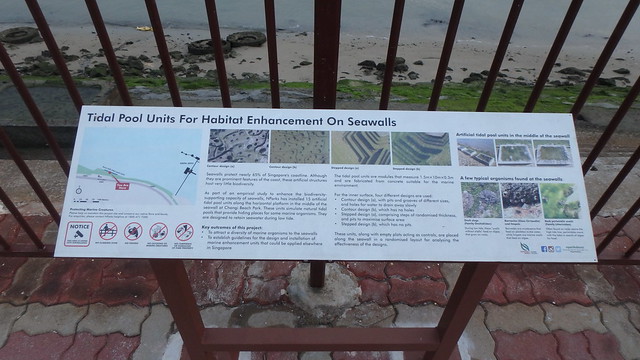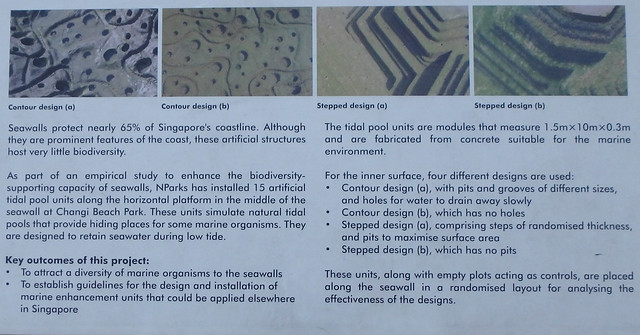We saw feather stars and many other echinoderms. The seagrass meadows are still lush and green, but seem quiet -- with not many of the usual animals we might find on Changi.
Most of the shore was covered in lush growths of Spoon seagrasses that were mostly fresh and green. I didn't see any other kinds of seagrasses. These were dotted with mostly Warty sea cucumbers, and some Thorny sea cucumbers. There were a few Haddon's carpet anemones.
Like other Changi seagrass meadows, there were many different kinds of sea cucumbers here. The most abundant were Pink warty sea cucumbers, with some Thorny sea cucumbers. There were also lots of Ball sea cucumbers buried and floating loose. I saw only one small Garlic bread sea cucumber, one Beige sea cucumber, and a few Orange sea cucumbers. Lisa also found a Sea apple sea cucumber.
I saw several small to medium sized Biscuit sea stars and one medium-sized Cake sea star as well as one Plain sand star. There were also some large White salmacis sea urchins.
The soft silty ground is great for burrowing animals like seapens. I saw several flowery sea pens, one Spiky sea pen, one slender sea pen and several Sea pencils.
I only saw one Peachia anemone and two small Tiger anemones.
I saw a few Common cerianthids. Most had black phoronid worms and one had other marinelife growing on its tube.
There are often animals living on other animals on a shore. Like this living crab, which had two different kinds of barnacles growing on its shell.
There were many Tiny carpet anemoneshrimps in the few Haddon's carpet anemones on the shore.
I saw several very large 'sand collars' which are the egg mass created by a Moon snail. The mama moon snail must have been very large! This sand collar had a Big hermit-hitching anemone on it. I also saw some Swimming crabs, some small Penaeid shrimps, many Orange-striped hermit crabs.
At the jetty, there are 'reefy' animals that grow on the legs. These include a pair of Miliaris cowries. But no sea fans which we saw on our survey in Jun 2013.
I saw four Blue feather stars here.
The artificial rocky shore has seaweeds and other marine life near the low water mark.
I saw a few small Noble volutes. Most of the living Gong gong snails I saw were young ones. I also saw some Window pane shell clams but no living Fan shell clams. We did not see any octopus. I suspect this shore continues to be subject to regular collection. I didn't see anyone collecting today, but did encounter this during our survey in Aug 2014.
During our survey, we saw the these structures that were probably constructed recently according to an MPA notice.
There's an explanation of what they are about: "Tidal Pool Units for Habitat Enhancement on Seawalls".
A closer look at the explanation.
Some of the 'pools' are full of water. Others are dry and empty. But all the pools are well above the low water mark where the seagrass and most of the marine biodiversity of Changi are found.
NParks' Marine Conservation Plan previously mentioned plans for "tidal pool units to be placed on a portion of the seawall at Changi Beach Park, Car Park 5 (CBP CP5). A total of 15 tidal pool units, with 3 different designs, will be installed at the area. Placement of the tidal pool units on CBP CP5 seawall". But so far, there has been no publicity or information to the community about these tidal pool units.
Erosion is a big problem on Changi's artificial shores. This is probably why there are wooden poles pounded in some stretches of the shore. And behind the poles, what looks like bags of sand.
Some of these poles have been washed out and are still on the shore. These probably scour the shore, preventing seagrasses from growing on the shore. I've noticed these fallen poles in Apr 2015. I wonder why the poles have not been removed?
In addition to the works on the seawalls, Today I noticed that Changi Coast Road has already been raised, as reported earlier as part of Singapore's response to the threat of rising seas. There was a bit of slope driving out from the carpark. On the shore, I noticed piles of soft clay-like material here and there, mostly in deeper water. Were these dug up? Who dug them up? Why?There's an explanation of what they are about: "Tidal Pool Units for Habitat Enhancement on Seawalls".
A closer look at the explanation.
Some of the 'pools' are full of water. Others are dry and empty. But all the pools are well above the low water mark where the seagrass and most of the marine biodiversity of Changi are found.
NParks' Marine Conservation Plan previously mentioned plans for "tidal pool units to be placed on a portion of the seawall at Changi Beach Park, Car Park 5 (CBP CP5). A total of 15 tidal pool units, with 3 different designs, will be installed at the area. Placement of the tidal pool units on CBP CP5 seawall". But so far, there has been no publicity or information to the community about these tidal pool units.
 |
| Figure 1: Placement of the tidal pool units on CBP CP5 seawall. |
Some of these poles have been washed out and are still on the shore. These probably scour the shore, preventing seagrasses from growing on the shore. I've noticed these fallen poles in Apr 2015. I wonder why the poles have not been removed?
I sense the shores are much quieter with fewer and less kinds of animals than on our last survey here in Apr 2015. Let's hope it can recover from all the works that have happened nearby.
Posts by others on this trip
- Lisa Lim on facebook.
Others on this trip: Neo Mei Lin, Nicholas Yap.





















